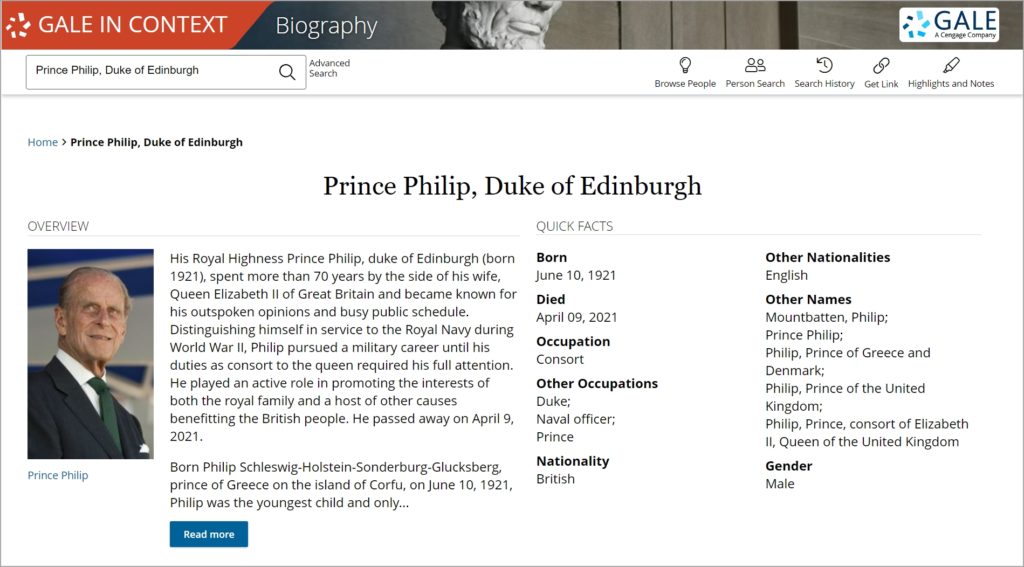|By Carol Brennan|
The remarkable reign of Britain’s Queen Elizabeth II ended on September 8, 2022, when the 96-year-old monarch died at Balmoral Castle in Scotland. Her astonishing 70-year reign—the longest of any British sovereign—might be measured by noting that when she ascended to the throne of the House of Windsor upon the death of her father, King George VI, in February 1952, there was no congratulatory message from Soviet leader Joseph Stalin.

Born in London on April 21, 1926, Princess Elizabeth of York was the first of two daughters of the former Elizabeth Bowes-Lyon and her husband, the Duke of York, who was the second son of the reigning monarch, King George V. At age 10, Elizabeth and her sister, Margaret, were said to have been deeply moved by the abdication crisis of 1936, when their beloved uncle Edward VIII renounced the throne to marry Wallis Simpson, a twice-divorced American. The father of Lilibet and Margot, as the young princesses were called by family, became King George VI and shepherded Britain through what was undoubtedly the most perilous era in its long history, when the country was at war with Nazi Germany during World War II and suffered heavy aerial bombardment.
Monarchies had been toppling for decades by then, and there were predictions that the considerably diminished British Empire would also fade away, with the royal family expected at best to become mere figureheads as well as living relics in the modern age of a feudal system based on birthright. The death of Elizabeth’s father in 1952 and the following year’s coronation—the first and, until 2022, the only one to be broadcast live on television—that installed her on the throne of the House of Windsor as Queen Elizabeth II marked the beginning of a tenure that would ultimately place her as the second-longest-reigning monarch in world history, surpassed only by King Louis XIV of France in the 1700s.
Queen Elizabeth was a married mother of two by the time of her Westminster Abbey coronation in June 1953. She produced two more sons, Andrew and Edward, who joined their sister Anne (born in 1950) and elder brother Charles (born in 1948). The Queen’s chief duties as head of state were the annual Opening of Parliament and a formal meeting with the leader of the political party who had achieved a majority in the general election. Winston Churchill was serving his second stint as prime minister when Elizabeth ascended to the throne, but she went on to summon 14 party leaders to confer privately with her and accept her invitation to form a government. They included Margaret Thatcher, who became the UK’s first female prime minister in 1979.
The most tenuous period in the seven-decade-long reign of Queen Elizabeth II came in the summer of 1997, when her former daughter-in-law, Princess Diana, died following an automobile crash in Paris. The House of Windsor was said to have been stunned by the outpouring of public grief over Diana’s death, but a series of crucial decisions made in the aftermath by the Queen served to diminish the threat of the United Kingdom becoming a republic.

Under her direction—and with the advice of Prince Charles, the aging heir to her throne—the Queen effected a surprisingly stunning public-relations victory over the next several years, culminating in the now-iconic cinematic stunt featuring actor Daniel Craig, as Agent 007 James Bond, accompanying her by helicopter to the opening ceremony at the 2012 London Summer Olympics. There is a long list of achievements and honors bestowed on the Queen, including her role as Supreme Governor of the Church of England and titular head of 2.4 billion citizens living in the 56 member-states of the Commonwealth of Nations, but perhaps the most endearing may have been her fondness for corgis, which dated back to a puppy she was given in 1933 at age seven; two of her corgis appeared in the famous 2012 London Olympics film, after which interest in the breed expanded considerably.
Revered by Britons in the final years of her reign for gamely weathering a long list of crises, from her adult children’s marital scandals to the death of her husband, Philip, Duke of Edinburgh, in 2021, Queen Elizabeth II delivered a final act of service a little more than 48 hours before her death, when she welcomed the new leader of the Conservative (Tory) Party, Liz Truss, at Balmoral Castle and issued the standard invitation to form a government on the Queen’s behalf. The last published photograph of the beloved British monarch showed a spry and smiling sovereign, dressed in a cardigan and tartan-plaid skirt, welcoming Truss to her sitting room at Balmoral Castle—a touching portrait that serves as a fitting close to her remarkable 23,226-day reign.

You can read more about Elizabeth II and other members of the royal family in Gale In Context: Biography.

About the Author
Carol Brennan has been writing biographical entries for Gale since 1993. If she’s not writing, she is either at yoga or walking her dachshund. Carol consumes an alarming volume of podcasts and audiobooks weekly.

